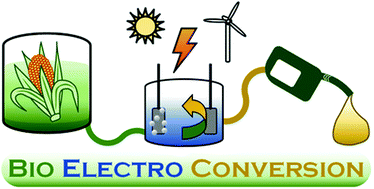当前位置:
X-MOL 学术
›
Energy Environ. Sci.
›
论文详情
Our official English website, www.x-mol.net, welcomes your
feedback! (Note: you will need to create a separate account there.)
Production of drop-in fuels from biomass at high selectivity by combined microbial and electrochemical conversion
Energy & Environmental Science ( IF 32.4 ) Pub Date : 2017-09-04 00:00:00 , DOI: 10.1039/c7ee01303e Carolin Urban 1, 2, 3, 4 , Jiajie Xu 5, 6, 7, 8 , Heike Sträuber 1, 2, 3, 4 , Tatiane R. dos Santos Dantas 1, 2, 3, 4 , Jana Mühlenberg 4, 9, 10, 11 , Claus Härtig 1, 2, 3, 4 , Largus T. Angenent 5, 6, 7, 8, 12 , Falk Harnisch 1, 2, 3, 4
Energy & Environmental Science ( IF 32.4 ) Pub Date : 2017-09-04 00:00:00 , DOI: 10.1039/c7ee01303e Carolin Urban 1, 2, 3, 4 , Jiajie Xu 5, 6, 7, 8 , Heike Sträuber 1, 2, 3, 4 , Tatiane R. dos Santos Dantas 1, 2, 3, 4 , Jana Mühlenberg 4, 9, 10, 11 , Claus Härtig 1, 2, 3, 4 , Largus T. Angenent 5, 6, 7, 8, 12 , Falk Harnisch 1, 2, 3, 4
Affiliation

|
Renewable electrical energy production, such as wind power or photovoltaics, faces temporal fluctuations and spatial separation of source and sink creating the need for suitable storage and conversion technologies. Furthermore, a bio-based economy needs technologies allowing the on-demand and on-site conversion of biomass to platform chemicals and chemical energy carriers. This study combines microbial and electrochemical conversions, allowing production of chemicals from biomass and electricity. Carboxylic acids (CAs) are produced by anaerobic conversion of a renewable feedstock with reactor microbiomes. CAs are subsequently electrochemically upgraded to yield energy-dense alkanes. We present a proof-of-concept based on experimental data for each step in two independent case studies at laboratory scale. During continuous CA fermentation from corn beer, mainly n-caproic and n-caprylic acid were produced yielding in total 0.638 g COD g−1 COD [CA/corn beer]. A batch system fed with corn silage yielded mainly n-butyric acid (0.207 g COD g−1 COD [CA/corn silage]), and some n-caproic acid (0.030 g COD g−1 COD [CA/corn silage]). The CAs were removed from the fermentation broth using a pertraction system. Subsequently, the CAs were electrochemically converted via Kolbe reaction and other reaction pathways. Depending on the carbon chain length of the CAs, liquid alkanes (from medium-chain CAs) or gaseous alkanes and alcohols (from short-chain CAs) were gained. Coulombic efficiencies of up to 80% were achieved despite the alkaline (pH 9) electrolysis conditions that are dictated by the pertraction system. Remarkably, CAs with a carbon chain length of six or more C-atoms were successfully converted to liquid alkanes at a high yield (in total: 0.480 g COD g−1 COD [hydrocarbon/corn beer]). This was achieved at an energy input of only 0.100 kW h per mol of converted CA (considering the electrochemical half cell reaction). Noteworthily, the electrochemical CA conversion is much faster than the CA fermentation, allowing intermittent electrolysis during periods of excess electrical power. We demonstrate that the finally gained product is suitable as a drop-in fuel without any further downstream processing. The future general potential as well as requirements for the concept are discussed.
中文翻译:

通过微生物和电化学转化,以高选择性从生物质生产直接燃料
可再生电能生产,例如风能或光伏发电,面临着时间波动以及源与汇的空间分隔,因此需要合适的存储和转换技术。此外,基于生物的经济需要允许生物量按需和现场转化为平台化学品和化学能载体的技术。这项研究结合了微生物和电化学转化,可以利用生物质和电力生产化学物质。羧酸(CAs)是通过可再生原料与反应器微生物组的厌氧转化而产生的。随后将CAs进行电化学升级,以生成能量密集的烷烃。我们在实验室规模的两个独立案例研究中,基于每个步骤的实验数据提供了概念验证。Ñ -caproic和Ñ -caprylic酸制作得在总0.638克COD克-1 COD [CA /玉米啤酒]。使用玉米青贮饲料的分批系统主要产生正丁酸(0.207 g COD g -1 COD [CA /玉米青贮])和一些正己酸(0.030 g COD g -1 COD [CA /玉米青贮]) 。使用吸引系统从发酵液中去除CA。随后,通过以下方式对CA进行电化学转化:Kolbe反应和其他反应途径。根据CA的碳链长度,获得了液态烷烃(来自中链CA)或气态烷烃和醇(来自短链CA)。尽管碱性(pH 9)的电解条件是由吸附系统决定的,但库仑效率仍可达到80%。值得注意的是,碳链长度等于或大于6个C原子的CA已成功地以高收率转化为液态烷烃(总计:0.480 g COD g -1COD [碳氢化合物/玉米啤酒]。每摩尔转化的CA仅输入0.100 kWh的能量即可实现这一点(考虑到电化学半电池反应)。值得注意的是,电化学CA的转化要比CA发酵快得多,从而可以在过剩的电能期间进行间歇性电解。我们证明,最终获得的产品无需任何进一步的下游加工即可作为直接燃料使用。讨论了未来的总体潜力以及对该概念的要求。
更新日期:2017-10-11
中文翻译:

通过微生物和电化学转化,以高选择性从生物质生产直接燃料
可再生电能生产,例如风能或光伏发电,面临着时间波动以及源与汇的空间分隔,因此需要合适的存储和转换技术。此外,基于生物的经济需要允许生物量按需和现场转化为平台化学品和化学能载体的技术。这项研究结合了微生物和电化学转化,可以利用生物质和电力生产化学物质。羧酸(CAs)是通过可再生原料与反应器微生物组的厌氧转化而产生的。随后将CAs进行电化学升级,以生成能量密集的烷烃。我们在实验室规模的两个独立案例研究中,基于每个步骤的实验数据提供了概念验证。Ñ -caproic和Ñ -caprylic酸制作得在总0.638克COD克-1 COD [CA /玉米啤酒]。使用玉米青贮饲料的分批系统主要产生正丁酸(0.207 g COD g -1 COD [CA /玉米青贮])和一些正己酸(0.030 g COD g -1 COD [CA /玉米青贮]) 。使用吸引系统从发酵液中去除CA。随后,通过以下方式对CA进行电化学转化:Kolbe反应和其他反应途径。根据CA的碳链长度,获得了液态烷烃(来自中链CA)或气态烷烃和醇(来自短链CA)。尽管碱性(pH 9)的电解条件是由吸附系统决定的,但库仑效率仍可达到80%。值得注意的是,碳链长度等于或大于6个C原子的CA已成功地以高收率转化为液态烷烃(总计:0.480 g COD g -1COD [碳氢化合物/玉米啤酒]。每摩尔转化的CA仅输入0.100 kWh的能量即可实现这一点(考虑到电化学半电池反应)。值得注意的是,电化学CA的转化要比CA发酵快得多,从而可以在过剩的电能期间进行间歇性电解。我们证明,最终获得的产品无需任何进一步的下游加工即可作为直接燃料使用。讨论了未来的总体潜力以及对该概念的要求。










































 京公网安备 11010802027423号
京公网安备 11010802027423号